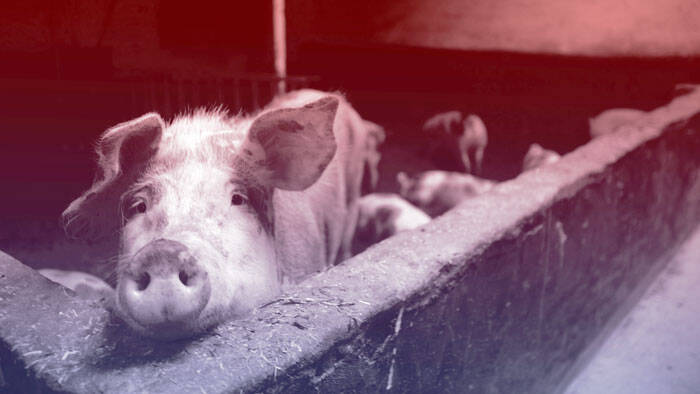













WHAT DO YOU WANT?
Rachel is co-founder, president, and CEO of Caribou Biosciences. She has a research background in CRISPR-Cas biology and also co-founded Intellia Therapeutics.
ABOUT RACHEL HAURWITZ
Photo: Caribou Biosciences

PEOPLE VS PIGS
She agrees that consumers are more skeptical when it comes to editing food. ‘The same technology is perceived completely differently. No parent will hesitate to use CRISPR if it would save their child. Yet when we want to use it to improve the overall health of pigs, there is resistance.’ This while, in theory, CRISPR could hold the key to ending world hunger.
A new breed of corn is currently in the works, for example, but is a ways away yet. Haurwitz: ‘It takes 17 years before you perfect a new breed of vegetable. A new drug takes 10 years to develop.’
CURE FOR SICK CELLS
Haurwitz also sees an opportunity for more precise cancer treatment. ‘What we hope to achieve is a treatment only attacking cancerous cells, and not the entire system the way chemotherapy does. Cellular medicine is the future and CRISPR will help us get there.’
CRISPR is still in need of extensive regulation. Four pros & cons
CRISPR & ETHICS

PIONEERING
American Rachel Haurwitz is one of the pioneers exploring CRISPR’s possible future applications. ‘This technology will help us prevent genetic diseases like sickle cell anemia. We expect human clinical trials to begin in the near future.’
DON'T TOUCH MY FOOD
Gene editing has applications in both healthcare and food production. When it’s used to cure debilitating disease not a lot of people would object to it, but when we use it to safeguard crops from blight, the subject suddenly becomes sensitive.
INCREDIBLY COMPLEX
The technology is unbelievably complex. It’s like combing through the entirety of the Library of Congress looking for a single misspelled word on a single page. The cas9 enzyme, however, knows exactly where to look and how to fix it.
Though it is an open question whether or not we want CRISPR technology near our food. These are some possible - and existing - applications in food.
CRISPR ON YOUR PLATE

CORRECTING ‘SPELLING ERRORS’
Over 3.000 different genetic diseases, ranging from color blindness to Huntington’s disease, are caused by only a single misplaced nucleotide in our DNA. By correcting these ‘spelling errors’ in our DNA, these thousands of diseases might be mere decades away from a cure.
CRISPR can also revive dormant genes, regulate genetic activity, or even add genes to our DNA. The enzyme cas9 is CRISPR’s tool of choice. Experts say CRISPR will mean a revolution in healthcare.
PLAYING WITH GENES
CRISPR is a technology that rewrites the code that makes up our cellular DNA. It’s short for Clustered Regularly Interspaced Short Palindromic Repeats. With CRISPR, we can cut and paste in our genetic sequence as if it was a Word document, and deactivate any erroneous code.
Hans Steenbergen & Frank Lindner Xiao-Er Kong
DNA is rewritable. We can rewrite it to combat disease, or to enhance performance. We can rewrite it in plants, but also in animals and even humans. Within the next couple of decades this technology will be used to create better nutrition and customized healthcare.



Photo: Caribou Biosciences








WHAT DO YOU WANT?
Rachel is co-founder, president, and CEO of Caribou Biosciences. She has a research background in CRISPR-Cas biology and also co-founded Intellia Therapeutics. She made the Forbes Magazine ‘30 Under 30’ list in Science and Healthcare in 2014. Fortune Magazine put her on the ‘40 Under 40’ list of most influential corporate people. Rachel invented several patents, and has a Ph.D in Molecular and Cell Biology from UC Berkeley.
ABOUT RACHEL HAURWITZ

She agrees that consumers are more skeptical when it comes to editing food. ‘The same technology is perceived completely differently. No parent will hesitate to use CRISPR if it would save their child. Yet when we want to use it to improve the overall health of pigs, there is resistance.’ This while, in theory, CRISPR could hold the key to ending world hunger.
A new breed of corn is currently in the works, for example, but is a ways away yet. Haurwitz: ‘It takes 17 years before you perfect a new breed of vegetable. A new drug takes 10 years to develop.’
PEOPLE VS PIGS
Haurwitz also sees an opportunity for more precise cancer treatment. ‘What we hope to achieve is a treatment only attacking cancerous cells, and not the entire system the way chemotherapy does. Cellular medicine is the future and CRISPR will help us get there.’
CURE FOR SICK CELLS
CON'S
- There is almost no regulation or legislation surrounding CRISPR
- The ethical lines are blurry. Would we use CRISPR on embryos to create designer babies?
- The technology is dangerous in the wrong hands, and could potentially be weaponized.
- Have we learned from past mistakes? The mistakes we made with GMO - loss of biodiversity, market monopolization - could easily happen again with CRISPR
PRO'S
- Previously incurable diseases will be a thing of the past
- CRISPR can greatly alleviate animal suffering
- In theory, the technology could mean the end of world hunger
- ’Traditional’ GMO practices add foreign genes to organisms. CRISPR works completely inside an organism’s own genetic code, without having to add anything from an outside source.
CRISPR is still in need of extensive regulation. Four pros & cons
CRISPR & ETHICS

American Rachel Haurwitz is one of the pioneers exploring CRISPR’s possible future applications. ‘This technology will help us prevent genetic diseases like sickle cell anemia. We expect human clinical trials to begin in the near future.’
PIONEERING
Gene editing has applications in both healthcare and food production. When it’s used to cure debilitating disease not a lot of people would object to it, but when we use it to safeguard crops from blight, the subject suddenly becomes sensitive.
DON'T TOUCH MY FOOD
The technology is unbelievably complex. It’s like combing through the entirety of the Library of Congress looking for a single misspelled word on a single page. The cas9 enzyme, however, knows exactly where to look and how to fix it.
INCREDIBLY COMPLEX
- Tomato growers have bred their plants in such a way that the tomatoes stay on the vine much longer.
- The company Calyx is developing new breeds of wheat. One of which has a much higher resistance to fungus, while another is low in carbohydrates but high in fiber.
- American company Recombinetics is using CRISPR to realize a breed of cows without horns, so they can’t accidently hurt one another.
- CRISPR can be used to combat decay in plants and other organisms. DuPont is using CRISPR to make yogurt resistant to various bacteriophages.
- In China, CRISPR/Cas9 is being used in breeding pigs. Gene editing allows pigs to better regulate their body temperatures and reduces their body fat by 24%. This allows them to survive during periods of extreme cold.
- In 2015, Penn State University used CRISPR to develop a type of white mushroom that does not turn brown over time.
Though it is an open question whether or not we want CRISPR technology near our food. These are some possible - and existing - applications in food.
CRISPR ON YOUR PLATE

Over 3.000 different genetic diseases, ranging from color blindness to Huntington’s disease, are caused by only a single misplaced nucleotide in our DNA. By correcting these ‘spelling errors’ in our DNA, these thousands of diseases might be mere decades away from a cure.
CORRECTING ‘SPELLING ERRORS’
CRISPR can also revive dormant genes, regulate genetic activity, or even add genes to our DNA. The enzyme cas9 is CRISPR’s tool of choice. Experts say CRISPR will mean a revolution in healthcare.
PLAYING WITH GENES
CRISPR is a technology that rewrites the code that makes up our cellular DNA. It’s short for Clustered Regularly Interspaced Short Palindromic Repeats. With CRISPR, we can cut and paste in our genetic sequence as if it was a Word document, and deactivate any erroneous code.

Hans Steenbergen & Frank Lindner Xiao-Er Kong
DNA is rewritable. We can rewrite it to combat disease, or to enhance performance. We can rewrite it in plants, but also in animals and even humans. Within the next couple of decades this technology will be used to create better nutrition and customized healthcare.








